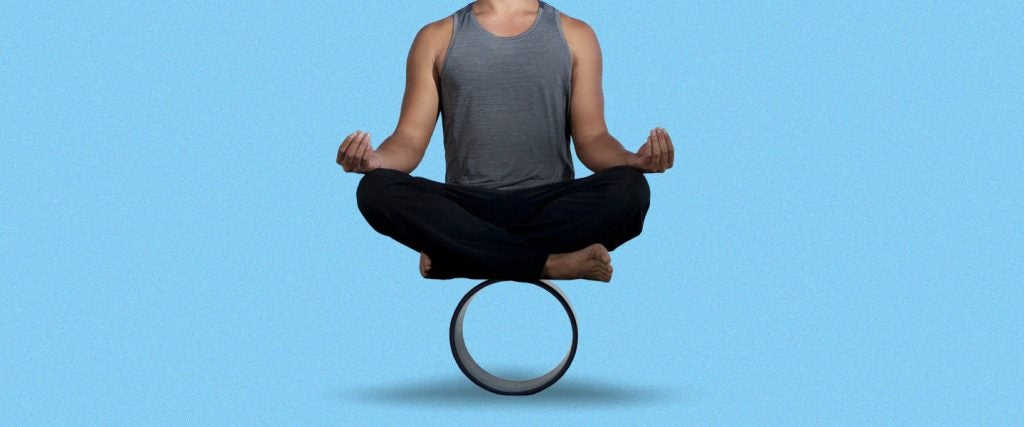I’m self-aware enough to know that there’s virtually no chance that I would ever have participated in even one yoga workout if it hadn’t been for Diamond Dallas Page’s transition from overachieving professional wrestler to the inimitable guru behind DDP Yoga. And you know what? I’m grateful to DDP for helping narrow-minded simpletons like me to see the value in yoga as a tool for the restoration and maintenance of joint strength and flexibility.
However, my interaction with yoga has been limited to the undisrupted link between my shoeless feet and a mat that’s been smoothly laid upon the floor. Never were any instruments or implements inserted into my yoga sessions. This admission may betray my lack of familiarity with what many people might regard as true yoga, but until recently, I wasn’t even aware of exactly how many accessories yoga aficionados incorporated into their training.
And when I did become aware of them, it wasn’t because they were receiving rave reviews. In particular, former NFL tight end and foam-roller guru Nate Lawrie introduced me to yoga wheels by explaining how they were wholly insufficient substitutes for foam rollers.
So what’s the deal? Are yoga wheels inept foam rollers, or do they have some other functionality that you can benefit from?
What on earth is a yoga wheel?
That’s an important question. This is a case in which we absolutely need to make sure we have our terms clear or we may run the risk of causing some generational confusion.
Not only is today’s yoga wheel not some first-millennium-BC apparatus connected with the ancient origins of yoga, but any version you can envision was crafted well within the last 100 years. To that end, in 1963, television executive Paul Eshleman invented what he called a “yoga wheel,” but contemporary viewers of the product would recognize it as an inversion table.
Eshleman explained to the New York Herald Tribune that he created his yoga wheel because he preferred to hang upside down like a bat while watching television, and also made the dubious claim that he’d lost 52 pounds and eight inches from his waist simply by engaging in his inverted TV viewing. Dubious or not, his invention was all the rage amongst the effete and elite influencers of New York in the early 1960s.
Of course, Eshleman’s yoga wheel had nothing at all to do with yoga, save for the reductivist thinking that any form of upside-down positioning constituted yoga in a substantive sense. Come to think of it, the inversion device also didn’t have anything of consequence to do with wheels aside from the shape of its turning mechanisms.
In contrast, the modern yoga wheel was created by Raquel Vamos and Dov Vargas, who introduced their product to the public as the founders of Dharma Yoga Wheel in the mid-2010s. It certainly has a legitimate connection with yoga as both of its inventors are accomplished yogis who incorporate the device into their classes. Moreover, the yoga wheel received a huge round of mainstream attention in August 2015 when the Associated Press blasted the image of Indianapolis Colts safety Mike Adams using a Dharma Yoga Wheel all across the U.S.
What is a yoga wheel intended to do?
Yoga wheels are designed to enhance yoga poses, while in some cases simplifying them. They also enable yoga practitioners to loosen key muscles by incorporating the wheel into various yoga poses, thereby permitting them to achieve greater flexibility throughout training sessions, and over the course of repeated use.
That sounds harmless. So what’s the problem?
As long as everyone stays in their appointed lanes, there is no problem. However, when yoga wheels are alternatively labeled as foam rollers for the sake of manipulating first-page search results on Amazon.com, the manufacturers and distributors of foam rollers become justifiably upset.
Frankly, customers should get at least a little upset as well — the two devices are dissimilar in both form and function. Yoga wheels are designed to boost flexibility, but foam rollers are constructed to flush post-workout lactic acid out of the muscles and aid recovery. A person desirous of these benefits who inadvertently purchases a yoga wheel is likely to be disappointed, and vice versa.
This is why it’s important to know the intended function of what you’re purchasing. Otherwise, you’re liable to be asking why your yoga wheel’s surface has so many funky ridges in it, and why your foam roller always leaves you hanging upside down.

